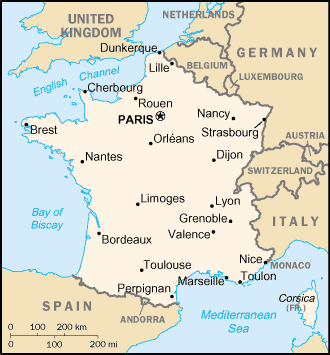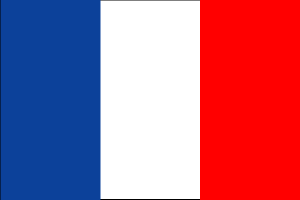
|
France
Background:
Although ultimately a victor in World Wars I and II, France suffered extensive
losses in its empire, wealth, manpower, and rank as a dominant nation-state.
Nevertheless, France today is one of the most modern countries in the world and
is a leader among European nations. Since 1958, it has constructed a
presidential democracy resistant to the instabilities experienced in earlier
parliamentary democracies. In recent years, its reconciliation and cooperation
with Germany have proved central to the economic integration of Europe,
including the advent of the euro in January 1999.
Location:
Western Europe, bordering the Bay of Biscay and English Channel, between
Belgium and Spain, southeast of the UK; bordering the Mediterranean Sea,
between Italy and Spain.
Area: total: 547,030 sq km, land: 545,630 sq km, note: includes only
metropolitan France; excludes the overseas administrative divisions, water:
1,400 sq km.
Area - comparative: Slightly less than twice the size of Colorado.
Land boundaries: Total: 2,889 km, border countries: Andorra 56.6 km, Belgium
620 km, Germany 451 km, Italy 488 km, Luxembourg 73 km, Monaco 4.4 km, Spain
623 km, Switzerland 573 km.
Coastline: 3,427 km.
Climate and Terrain:
Climate: Generally cool winters and mild summers, but mild winters and hot
summers along the Mediterranean; occasional strong, cold, dry,
north-to-northwesterly wind known as mistral.
Terrain: Mostly flat plains or gently rolling hills in north and west;
remainder is mountainous, especially Pyrenees in south, Alps in east.
People:
Population: 59,765,983.
Ethnic groups: Celtic and Latin with Teutonic, Slavic, North African,
Indochinese, Basque minorities.
Religions: Roman Catholic 83%-88%, Protestant 2%, Jewish 1%, Muslim 5%-10%,
unaffiliated 4%.
Languages: French 100%, rapidly declining regional dialects and languages
(Provencal, Breton, Alsatian, Corsican, Catalan, Basque, Flemish).
Government:
Government type: Republic.
Capital: Paris.
Economy overview:
France is in the midst of transition, from a well-to-do modern economy that
featured extensive government ownership and intervention to one that relies
more on market mechanisms. The Socialist-led government has partially or fully
privatized many large companies, banks, and insurers, but still retains large
stakes in several leading firms, including Air France, France Telecom, Renault,
and Thales, and remains dominant in some sectors, particularly power, public
transport, and defense industries.
Statistics:
Telephones - main lines in use: 34.86 million.
Telephones - mobile cellular: 11.078 million.
Radio broadcast stations: AM 41, FM about 3,500 (this figure is an
approximation and includes many repeaters).
Radios: 55.3 million.
Television broadcast stations: 584 (plus 9,676 repeaters).
Televisions: 34.8 million.
Internet users: 11.7 million.
Railways: Total: 31,939 km .
Highways: Total: 892,900 km.
Airports: with paved runways: 270, with unpaved runways: 207.
Heliports: 3.
Return to Visiting Locations
|

